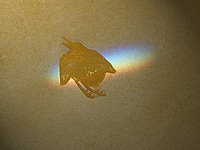 ApXos is easier to type than Applied Chaos -- which is both my company's name, and my state of being. I chose that name for my company ten years ago -- before I had a company. Reading an article about chaos theory applied to the study of electrical impulses across the heart, I put those words together and thought they perfectly described my approach to creating stuff.
ApXos is easier to type than Applied Chaos -- which is both my company's name, and my state of being. I chose that name for my company ten years ago -- before I had a company. Reading an article about chaos theory applied to the study of electrical impulses across the heart, I put those words together and thought they perfectly described my approach to creating stuff.In math & physics, chaos theory attempts to model the behavior of systems that appear to be random. Successful models of these systems actually prove to be deterministic (well defined, with no random parameters), and the "chaotic" behavior actually derives from sensitivity to initial conditions, that is, a small change in conditions at the start of the model may prove to have dramatic variations in the direction or outcome of the model. So, even systems we perceive to be chaotic prove to be orderly after a fashion, once we truly understand the model.
While theorists focus on modelling the weather or financial systems or population movements, I've been applying the concept to the artistic process. Truly, from the outside this appears to be a chaotic system. We know that presented with the same opportunity, no two people will draw, sculpt, paint, design, or problem-solve in exactly the same way. Is this symptomatic of a sensitivity to initial conditions? I've been exploring this possibility as an artist, and not as a mathemetician, however, and so you probably won't find many interesting mathematical models popping out of my work here.
What may emerge though, is insight into chaotic processes that surround almost any creative or entreprenurial endeavor. Some we have labelled with angry words like: procrastination, resistance, blocks, laziness, attention deficit. We observe erratic behavior among "creatives" -- engineers who leave their desks to play ping pong during a crisis, woodworkers who waste time sweeping the floor just prior to making mountains of sawdust, writers who suddenly take up ice skating two weeks before deadline, and make the deadline by pulling all-nighters.
I've found that these are actually symptoms of the creative process in action. I've observed these and other symptoms at work in the many different kinds of creative teams I've led or been a member of. The most effective teams and individuals are those who have learned to treat these symptoms as friends. The most troubled are those who internalize the negative words, and denigrate themselves, their work, or their vision and give up before they reach their goals.
It is my hope that sharing my insights (and the insights of others that have helped me) will guide us to the "strange attractors" of the art world -- the beautiful and mysterious patterns of creativity.
No comments:
Post a Comment